|
Page
36
|
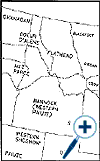
Map showing general areas inhabited by Native American tribes in Idaho, early 1800s. Modified from Beck and Haase (1989, map 8).
Click on image for a larger view.
|
|||
 |
Map showing general areas inhabited by Native American tribes in Idaho, early 1800s. Modified from Beck and Haase (1989, map 8). Click on image for a larger view. |
||
Native
Americans and the Fur Trappers
The Pacific Northwest
was populated by several native tribes and all early European visitors had contact
with one or more of them. These relationships ranged from friendly visits to
violent encounters. Overall, at the outset, relationships were cordial and often
mutually advantageous. As time went on and the threat of loss of food sources
and free movement increased, tensions developed to the detriment of the native
population. The superior technology of the Europeans, their unity and cohesive
purposes, plus the overwhelming influence of military power, forced native populations
into increasingly unfavorable circumstances and resulted ultimately in their
total subjection.
The two southern groups differ from the three northern groups both in language and in culture. Today, almost all of the Shoshone and Bannocks live on the Fort Hall Indian Reservation. The Shoshone form the great majority. A few tribal members live on the Duck Valley Reservation in southwestern Idaho.
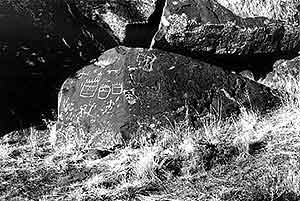 |
| Petroglyphs on basalt boulder south of Ross Park in Pocatello. The dark surface of basalt was particularly easy to carve and is one of the main places where Native American rock art is found. The petroglyphs are less than 10,000 years old, (October, 1992) |
Antiquity
of Native Americans in Idaho
Archeology keeps
pushing back in time estimates of how long native populations have lived in
the Snake River Plain area. Excavations of inhabited sites now indicate there
have been humans in southern Idaho for at least 11,000 years. Whether these
residents were the ancestors of the current tribes is a subject of debate (Swanson,
1972; Lohse and Holmer, 1990). Certainly, peoples existed in the wetter, more
habitable areas of the Pacific coast for a longer period. Over time, settlement
spread into arid desert lands as far south as the Mexican border and into the
deserts of southern Idaho and northern Utah.
Prior to the introduction of the horse, the Indians of Idaho apparently lacked permanent band organization, formal chieftainship and tribal political unification; rather they existed in groups of family-clusters. By the mid-eighteenth century, however, contacts with European culture and the acquisition of horses brought about a transformation in the native way of life. Political organization developed, new sources of food became available, and increased mobility permitted wide-ranging contacts with other native populations. Apparently, yearly festivals took place, attended by tribes from eastern Oregon and Washington, along with the northern and southern Idaho tribes mentioned above and tribes from Utah.
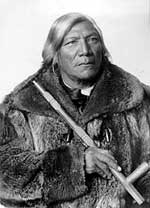 |
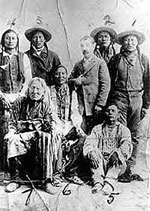 |
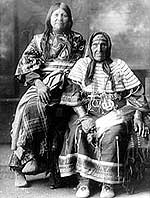 |
|
(left) Portrait of Pat Tahee (Tyhee), early 1900s. Mary Garvey photograph, Wrensted collection, Idaho Museum of Natural History. (center) Indians at the Fort Hall Drug Store, about 1895. The numbers are as follows. 1. Tom Edmo; 2. Chas. Deepwater; 3. Percy Edmo; 4. Canaker (canker) Johnson; 5. Johnnie Gibson; 6. Geo. Edmo, 7. Chief Arimo; the white man is Cye Napper, druggist. Abe Lillibridge collection, Eli Oboler Library, Idaho State University. (right) Portrait of two Native American Women, Old Wazipe (left) and "Old Mari: ci"; photo taken between 1895-1912, probably before 1900. Benedicte Wrensted Photograph, Idaho Museum of Natural History. |
||
The
Bannock and the Shoshoni
Very early in this
development, members of the Northern Paiute (bannock) population from Oregon
who adopted the horse culture began to associate with the mounted Shoshoni bands,
joining them in hunting expeditions. They intermarried and ultimately became
bilingual and culturally and politically integrated. Sven Liljeblad (1959) noted
that nowhere was there a Bannock society separated culturally and politically
from the Shoshoni society. Thus he considered this to be not the combination
of two differing cultures, but of two different languages into a new culture.
The Paiute speakers who melded into the Shoshoni horse groups called themselves
"pannakwaty," meaning, presumably, "being on the west side"
(of the water, or river). Early white men writing of this used various terms
such as "Pannacks" or "Bonacks" and ultimately the term
came to be "Bannock."
The range of the Shoshoni-Paiute tribes was in southern Idaho and northern Utah. Identification of various groups was often related to their foods, such as "Sheepeaters," "Salmon eaters" and "Buffalo eaters." The names changed often and had little significance to the tribes themselves. Such terms did not denote culturally distinct, politically independent tribes and are interchangeable, depending on circumstances.
The two languages (Shoshone and Paiute) still exist on the Fort Hall Reservation, although very few can now speak Paiute. The culture and skills which sustained the native tribes of southern Idaho have nearly disappeared; most of the cultural attributes now propounded have been relearned in recent times, through efforts to reestablish old values.
|
As Dr. Sven Liljeblad
stated in 1959: |